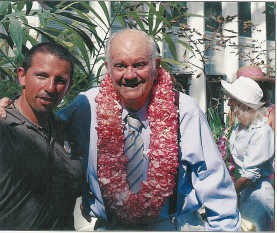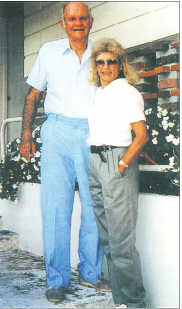The William F. Whitman Tropical Fruit Pavilion
Richard J. Campbell, Ph.D. Senior Curator of Tropical Fruit
Garden Views, Autumn 2003
Photographs: author's collection
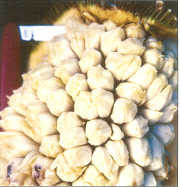
The delectable Asian tarap (Artocarpus odoratissimus)
Garden benefactor William F. Whitman has long been driven by the desire to be the first to bring to fruit the most exotic of tropical species-plants whose cultural requirements are unknown or hard to achieve here in South Florida. He has dedicated the better part of a lifetime to this quest. A stroll around his Bal Harbour garden is a living testament to his vision. His fruit garden features the very finest selections from the world of tropical fruit, painstakingly cultivated to coax the best out of each tree.
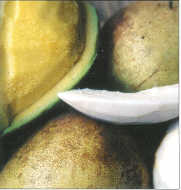
Bembangan (Mangifera pajang) and binjai (Mangifera caesia)
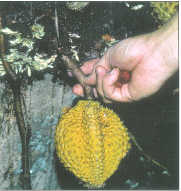
Durian kura kura on the tree (Durio testudinarium)
Soon Mr. Whitman will expand the influence of his work with the dedication this November of the William F. Whitman Tropical Fruit Pavilion at Fairchild Tropical Botanic Garden. The pavilion, funded by the generous million-dollar endowment from the Whitman family, will allow Fairchild to bring these exotic beauties to the public eye and, ultimately, to secure their future in this hemisphere.
Nearly a century has passed since Dr. David Fairchild first wrote about the immense potential of exotic tropical fruit in the Americas. He and other tropical fruit pioneers like Wilson Popenoe were enchanted by the allure of exotic tropical fruit and they predicted their emergence in the mainstream United States marketplace. Yet, as we enter the new millennium, the durian, mangosteen, duku and tarap remain unknown, or, at best, recognized only as novelties by a few consumers in the United States. We are confident the situation is soon to change. With the opening of the Whitman Tropical Fruit Pavilion, research to determine suitable cultivation techniques can be carried out, allowing the century-old dreams of David Fairchild and Wilson Popenoe to become reality. With the knowledge gained, exotic tropical fruit could be finally produced commercially and marketed in the Americas.
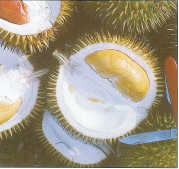
Fiery reds and yellows of the durian kuning (Durio graveolens)
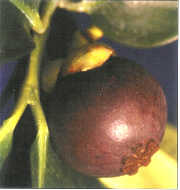
Mangosteen (Garcinia mangostana), the queen of fruits
The Whitman Pavilion has been designed to provide the necessary roof height, the low pH soil and the superior water quality necessary to grow and bring to fruit the world's most alluring treasures. Imagine the sight of a mature mangosteen (Garcinia mangostana) tree, heavily laden with its legendary deep purple fruit, or the earthy sweetness of the salak or snake fruit, Salacca zalacca. Visitors will be able to bask in the shade of the majestic Asian tarap (Artocarpus odoratissimus), while the intoxicating aromas of the durian kura-kura (Durio testudinarium) and bembangan (Mangifera pajang) whisk you away to a new experience.
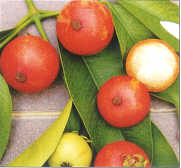
The tart and tasty beach mangosteen (Garcinia hombroniana)
For the first time in history, this delightful experience will be possible within the boundaries of the mainland United States. Like the Garden itself, the new Pavilion is more than a display exhibit to please the senses. Each priceless specimen tree has been carefully selected for its scientific and horticultural value.
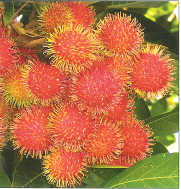
The eye-stopping reds of the rambutan (Nephelium lappaceum)
Superior clones provide the framework of the Whitman Tropical Fruit Pavilion collection, the result of numerous collecting expeditions over the last decade to the Amazon Basin, Brunei Darussalam, Indonesia, Malaysia and Thailand. The specimens brought back are superior clones — the result of decades of selection both by native peoples and horticultural researchers. We need this improved stock to achieve our goals of earlier fruiting, manageability and consistent fruit quality.
The use of seedlings has doomed many projects, including some of the pioneering efforts of Dr. David Fairchild himself.
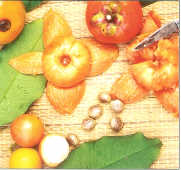
The lovely button mangosteen (Garcinia prainiana)
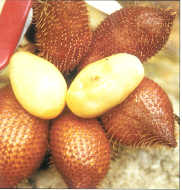
The exotic beauty of the salak (Salacca zalacca)
The Tropical Fruit Program is committed to innovative horticultural propagation and pruning techniques, keeping the work carried out at Whitman Tropical Fruit Pavilion on the cutting edge of technology. These tools will allow us to mold our specimen trees to the size limitations of the Pavilion structure and to determine the degree of their adaptability to modern production systems. Only then can we move towards making exotic fruit a viable commercial option in this hemisphere.
The Whitman Tropical Fruit Pavilion, as a public showcase for the Fairchild Tropical Fruit Program, will further Mr. Whitman's dream of bringing superior tropical fruit to the Americas. We want to make these fruits more available to the average person. We can make use of genetic and horticultural advancements to enhance the status of exotic tropical fruit in this hemisphere. Thanks to the vision and philanthropy of William E Whitman, we have a suitable program and the necessary tools in the Whitman Pavilion. It is time to put the trees in the ground and our plans to the test.
